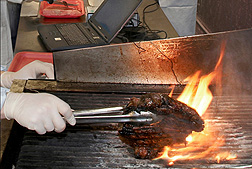This page has been archived and is being provided for reference purposes only. The page is no longer being updated, and therefore, links on the page may be invalid.
Does Grilling Kill E. coli O157:H7?
By Marcia WoodJune 28, 2011
Top sirloin steaks have been getting a grilling in U.S. Department of Agriculture (USDA) food safety studies. USDA microbiologist John B. Luchansky and his colleagues are conducting experiments to help make sure that neither the foodborne pathogen Escherichia coli O157:H7 nor any of its pathogenic relatives will ruin the pleasure of eating this popular entrée.
The scientists are learning more about the movement of E. coli into "subprimals," the meat from which top sirloin steaks are carved. Their focus is on what happens to the E. coli when subprimals are punctured-as part of being tenderized-and the effect of cooking on survival of those microbes.
Luchansky is with USDA's Agricultural Research Service (ARS), based at the agency's Eastern Regional Research Center in Wyndmoor, Pa. ARS is the USDA's principal intramural scientific research agency.
In early studies, the researchers applied various levels of E. coli O157:H7 to the "lean-side" surface of subprimals, ran the meat (lean side up) through a blade tenderizer, and then took core samples from 10 sites on each subprimal, to a depth of about 3 inches. In general, only 3 to 4 percent of the E. coli O157:H7 cells were transported to the geometric center of the meat. At least 40 percent of the cells remained in the top 0.4 inch.
Next, the group applied E. coli to the lean-side surface of more subprimals, put the meat through a blade tenderizer, then sliced it into steaks with a thickness of three-fourths of an inch, 1 inch, or 1.25 inches. Using a commercial open-flame gas grill, they cooked the steaks-on both sides-to an internal temperature of 120 degrees Fahrenheit (very rare), 130 degrees F (rare), or 140 degrees F (medium rare).
The findings confirmed that if a relatively low level of E. coli O157:H7 is distributed throughout a blade-tenderized top sirloin steak, proper cooking on a commercial gas grill is effective for eliminating the microbe.
Luchansky conducted the studies with Wyndmoor colleagues Jeffrey E. Call, Bradley A. Shoyer, and Anna C.S. Porto-Fett; Randall K. Phebus of Kansas State University; and Harshavardhan Thippareddi of the University of Nebraska.
Published in the Journal of Food Protection in 2008 and 2009, these preliminary findings have paved the way to newer investigations. The research enhances food safety, a USDA top priority.

